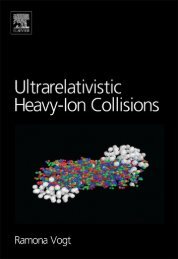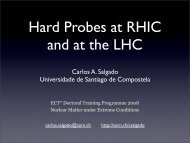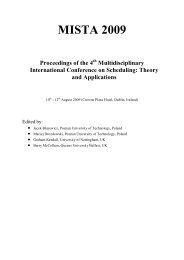Advances in perturbative thermal field theory - Ultra-relativistic ...
Advances in perturbative thermal field theory - Ultra-relativistic ...
Advances in perturbative thermal field theory - Ultra-relativistic ...
Create successful ePaper yourself
Turn your PDF publications into a flip-book with our unique Google optimized e-Paper software.
Thermal <strong>field</strong> <strong>theory</strong> 387<br />
equations of motion are given by<br />
∫<br />
[D µ ,F µν ] a = j νa = ˆm 2 dv<br />
D<br />
4π vν W a (x, v), (6.7)<br />
[v · D, W(x, v)] a = v · E a (x), (6.8)<br />
where E is the chromo-electric <strong>field</strong> strength and W a (x, x) describes the fluctuations of the<br />
phase space density of hard gluons. At the expense of <strong>in</strong>troduc<strong>in</strong>g W a (x, x) as a new soft<br />
degree of freedom, this formulation permits a completely local description of the physics of<br />
soft gauge-boson modes [300, 301].<br />
The HTL diagrams can be constructed from solv<strong>in</strong>g (6.7) <strong>in</strong> terms of jµ a [A] and formally<br />
expand<strong>in</strong>g<br />
jµ a ab<br />
=−ˆ µν Aν b + 1 abc ˆƔ<br />
2 µνρ Aν b Aρ c + ···. (6.9)<br />
The k<strong>in</strong>etic-<strong>theory</strong> approach also allows one to consider strong deviations from<br />
equilibrium. In [302–304] the analogue of the HTL self-energies with anisotropic momentum<br />
distributions has been considered, which turns out to lead to space-like s<strong>in</strong>gularities <strong>in</strong> the<br />
gauge-boson propagator. The latter are related to plasma <strong>in</strong>stabilities that could play an<br />
important role <strong>in</strong> <strong>thermal</strong>ization issues [305, 306].<br />
6.3. HTL /HDL resummation<br />
S<strong>in</strong>ce for soft momenta ∼gT HTL self-energies and vertices are equally important as the<br />
tree-level self-energies and vertices, the former may not be treated <strong>perturbative</strong>ly but should<br />
rather be comb<strong>in</strong>ed with the latter to form effective self-energies and vertices. This can be<br />
done formally by replac<strong>in</strong>g<br />
L cl → L cl + L HTL − δ × L HTL , (6.10)<br />
where δ is a parameter that is sent to 1 <strong>in</strong> the end, after the last term has been treated as a<br />
‘<strong>thermal</strong> counterterm’ by assum<strong>in</strong>g that δ counts as a one-loop quantity.<br />
Because L HTL has been derived under the assumption of soft external momenta, this<br />
prescription is <strong>in</strong> fact only to be followed for soft propagators and vertices [213]. Propagators<br />
and vertices <strong>in</strong>volv<strong>in</strong>g hard momenta (if present) do not require this resummation, and <strong>in</strong><br />
fact for obta<strong>in</strong><strong>in</strong>g a systematic expansion <strong>in</strong> the coupl<strong>in</strong>g g, one has to expand out all HTL<br />
<strong>in</strong>sertions on hard <strong>in</strong>ternal l<strong>in</strong>es. In practice, a separation between hard and soft scales may be<br />
implemented by <strong>in</strong>troduc<strong>in</strong>g an <strong>in</strong>termediate scale with gT ≪ ≪ T , assum<strong>in</strong>g g ≪ 1,<br />
for example ∝ √ gT (see, e.g. [307, 308]).<br />
The result<strong>in</strong>g systematic expansions <strong>in</strong> g typically <strong>in</strong>volve s<strong>in</strong>gle powers <strong>in</strong> g and<br />
logarithms of g, <strong>in</strong> contrast to conventional perturbation <strong>theory</strong>, which would <strong>in</strong>volve only<br />
g 2 as an expansion parameter. This is because <strong>in</strong>creas<strong>in</strong>g the loop order by one <strong>in</strong>volves<br />
a factor g 2 T that <strong>in</strong> an ultra<strong>relativistic</strong> situation and soft external momenta gT is made<br />
dimensionless by a <strong>thermal</strong> mass m ∼ gT , so that the effective expansion parameter becomes<br />
g 2 T/m ∼ g.<br />
The same resummation scheme arises <strong>in</strong> the presence of a chemical potential. In the<br />
effective action, the chemical potential enters only <strong>in</strong> the mass parameters ˆM 2 and ˆm 2 D accord<strong>in</strong>g<br />
to (5.28) and (5.18). For T ≈ 0 but large µ f , the HTLs have also been nicknamed ‘ HDLs’ [309].<br />
At T ≈ 0, resummation of the HDL effective action is necessary for soft momenta gµ,but<br />
because of the absence of Bose enhancement, this does not give rise to s<strong>in</strong>gle powers of g <strong>in</strong><br />
the perturbations series but only to logarithms of g <strong>in</strong> addition to powers of g 2 , as found long<br />
ago <strong>in</strong> the r<strong>in</strong>g resummation scheme of Gell-Mann and Brueckner [310] for an electron gas at







